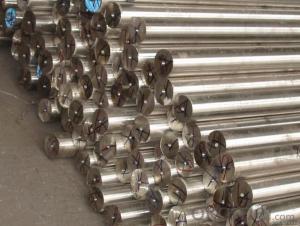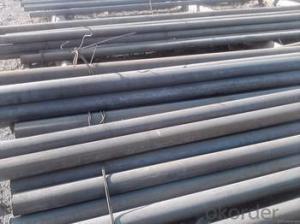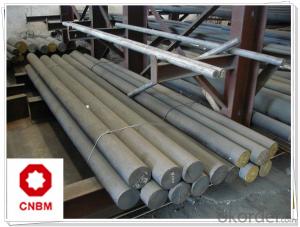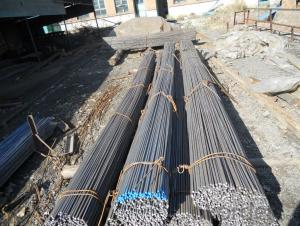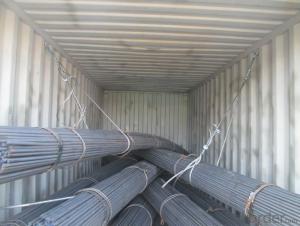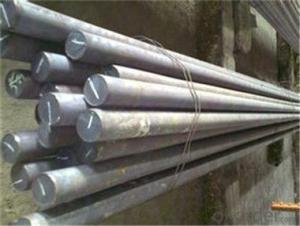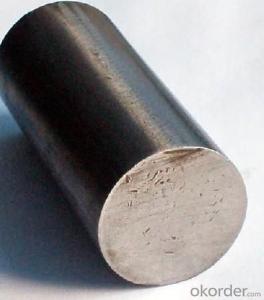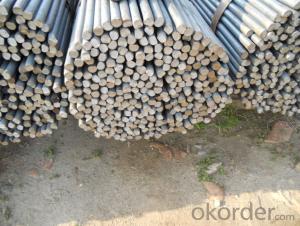Steel Round Bar Made in China with High Quality and Competitive Prices
- Loading Port:
- Tianjin
- Payment Terms:
- TT or LC
- Min Order Qty:
- 30 m.t.
- Supply Capability:
- 40000 m.t./month
OKorder Service Pledge
OKorder Financial Service
You Might Also Like
Product Description:
OKorder is offering Steel Round Bar Made in China with High Quality and Competitive Prices at great prices with worldwide shipping. Our supplier is a world-class manufacturer of steel, with our products utilized the world over. OKorder annually supplies products to European, North American and Asian markets. We provide quotations within 24 hours of receiving an inquiry and guarantee competitive prices.
Product Applications:
Steel Round Bar Made in China with High Quality and Competitive Prices are ideal for structural applications and are widely used in the construction of buildings and bridges, and the manufacturing, petrochemical, and transportation industries.
Product Advantages:
OKorder's Steel Round Bar Made in China with High Quality and Competitive Prices are durable, strong, and resist corrosion.
Main Product Features:
· Premium quality
· Prompt delivery & seaworthy packing (30 days after receiving deposit)
· Corrosion resistance
· Can be recycled and reused
· Mill test certification
· Professional Service
· Competitive pricing
Packaging & Delivery:
Packaging Detail: products are packed in bundle and then shipped by container or bulk vessel, deformed bar is usually naked strapping delivery, when storing, please pay attention to moisture proof. The performance of rust will produce adverse effect.
Each bundle weight: 2-3MT, or as required
Payment term: TT or L/C
Delivery Detail: within 45 days after received advanced payment or LC.
Label: to be specified by customer, generally, each bundle has 1-2 labels
Trade terms: FOB, CFR, CIF
FAQ:
Q1: Why buy Materials & Equipment from OKorder.com?
A1: All products offered byOKorder.com are carefully selected from China's most reliable manufacturing enterprises. Through its ISO certifications, OKorder.com adheres to the highest standards and a commitment to supply chain safety and customer satisfaction.
Q2: How do we guarantee the quality of our products?
A2: We have established an advanced quality management system which conducts strict quality tests at every step, from raw materials to the final product. At the same time, we provide extensive follow-up service assurances as required.
Q3: How soon can we receive the product after purchase?
A3: Within three days of placing an order, we will begin production. The specific shipping date is dependent upon international and government factors, but is typically 7 to 10 workdays.
Images:

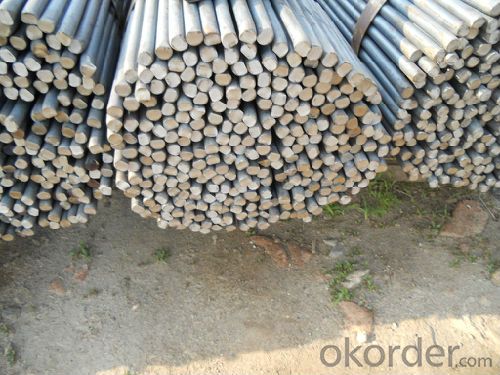
- Q: What are the disadvantages of using steel round bars?
- There are a few disadvantages associated with using steel round bars. Firstly, steel round bars can be quite heavy, making them difficult to handle and transport. Secondly, steel round bars can corrode if not properly protected, which can lead to structural weakness and reduced lifespan. Additionally, steel round bars may not be suitable for certain applications that require lightweight or non-magnetic materials. Lastly, steel round bars can be more expensive compared to other materials, which may impact the overall project cost.
- Q: Can steel round bars be used in the manufacturing of electrical components?
- Indeed, the utilization of steel round bars is feasible in the production of electrical components. The malleable nature of steel renders it a flexible material that endows exceptional vigor and robustness, thus rendering it apt for a plethora of applications, including the manufacturing of electrical components. Steel round bars can be employed as linkages, connectors, or supports in electrical devices and apparatus. Consequently, they impart stability, reinforcement, and shielding to the electrical components, guaranteeing their optimal operation and protracted lifespan. Furthermore, steel is easily machinable, weldable, and moldable, thereby enabling manufacturers to tailor the round bars to the specific requirements of the electrical components. Nevertheless, one must bear in mind that depending on the precise application and environment in which they are employed, steel round bars may necessitate appropriate insulation or coating to prevent any electrical conductivity or interference.
- Q: What are the different types of carbon steel round bars?
- There are several different types of carbon steel round bars, including low carbon steel, medium carbon steel, and high carbon steel. Each type has varying levels of carbon content, which determines its strength and hardness. Low carbon steel round bars have the lowest carbon content and are more easily welded and formed. Medium carbon steel round bars have a higher carbon content and are stronger and more durable, making them suitable for applications that require higher strength. High carbon steel round bars have the highest carbon content and are extremely strong and hard, making them ideal for applications that require maximum strength and wear resistance.
- Q: Can steel round bars be heat treated to improve their mechanical properties?
- Yes, steel round bars can be heat treated to improve their mechanical properties. Heat treatment involves heating the steel to a specific temperature and then cooling it at a controlled rate. This process can alter the microstructure of the steel, resulting in improved hardness, strength, and toughness. Different heat treatment methods, such as quenching and tempering, can be applied depending on the desired mechanical properties.
- Q: Are steel round bars susceptible to corrosion?
- Yes, steel round bars are susceptible to corrosion.
- Q: How are steel round bars used in the manufacturing of lifting equipment?
- Due to their strength, durability, and versatility, steel round bars are commonly used in the manufacturing of lifting equipment. These bars are typically made from high-quality steel alloys like carbon steel or alloy steel, which provide the necessary strength and toughness for lifting heavy loads. In the manufacturing process, steel round bars serve as the main structural component of lifting equipment such as cranes, hoists, and lifting hooks. They are utilized to create the frame and support structures that ensure stability and load-bearing capacity. Moreover, steel round bars are employed to fabricate various lifting components like shafts, axles, and pins. These components play a crucial role in the proper functioning of lifting equipment and are designed to withstand high levels of stress and strain. The use of steel round bars guarantees that they can handle heavy loads without deforming or failing. Additionally, steel round bars are frequently used to manufacture lifting hooks and chains. Lifting hooks are essential for attaching the load to the lifting equipment, while chains secure and lift the load. Steel round bars provide the necessary strength and rigidity to handle the weight of the load, ensuring safe and efficient lifting operations. Furthermore, manufacturers can machine, forge, or heat-treat steel round bars to achieve specific mechanical properties required for lifting equipment manufacturing. This flexibility allows manufacturers to customize the bars to meet the specific requirements of different lifting applications, such as withstanding high temperatures or resisting corrosion. In conclusion, steel round bars are indispensable in the manufacturing of lifting equipment. Their strength, durability, and versatility make them ideal for creating the structural frames, support structures, and lifting components necessary for safe and efficient lifting operations.
- Q: Can steel round bars be used in the manufacturing of tools?
- Yes, steel round bars can be used in the manufacturing of tools. Steel round bars are commonly used in tool manufacturing due to their high strength, durability, and versatility. They provide the necessary structural integrity and toughness required for various tools, such as wrenches, hammers, chisels, and screwdrivers. The round shape of the bar allows for easy machining and shaping into different tool components. Additionally, steel round bars can be heat treated to enhance their hardness and wear resistance, making them suitable for heavy-duty and high-performance tool applications.
- Q: Can steel round bars be used for making rebar?
- Yes, steel round bars can be used for making rebar. In fact, many rebar manufacturers use steel round bars as a primary material for producing rebar due to their strength and durability.
- Q: What is the difference between carbon steel and stainless steel round bars?
- The composition and properties of carbon steel and stainless steel round bars differ significantly. Carbon steel round bars are composed primarily of iron and carbon, with trace amounts of other elements. They are renowned for their strength and durability, making them ideal for use in industries like construction and automotive. In terms of affordability, carbon steel round bars are generally more cost-effective than stainless steel round bars. In contrast, stainless steel round bars are a type of steel alloy that contains a minimum of 10.5% chromium. This addition of chromium gives stainless steel its distinct properties, including resistance to corrosion. As a result, stainless steel round bars are highly resistant to rust and staining, making them suitable for use in environments exposed to moisture and chemicals. Industries such as food processing, medical equipment, and marine applications commonly utilize stainless steel round bars. The chromium content in stainless steel round bars generally leads to higher prices compared to carbon steel round bars. However, the added cost is justified by the superior corrosion resistance and aesthetic appeal of stainless steel. Furthermore, stainless steel offers a range of grades and finishes, allowing for customization based on specific requirements. In conclusion, the primary distinction between carbon steel and stainless steel round bars lies in their composition and properties. Carbon steel is known for its strength and affordability, while stainless steel provides corrosion resistance and various customization options. The choice between the two depends on the specific application and the desired properties required for the project.
- Q: What are the different types of steel round bar alloys for improved strength?
- Various steel round bar alloys are known for their enhanced strength. These alloys are developed by adding different elements to the steel composition, resulting in varying properties and strengths. Carbon steel is a commonly used alloy for increased strength. It contains a higher carbon content, which enhances its strength and hardness. Carbon steel round bars are widely utilized in applications that require high strength, such as construction, automotive, and machinery. Stainless steel is another alloy known for its corrosion resistance and high strength. Stainless steel round bars are frequently employed in environments where corrosion is a concern, such as marine applications, food processing, and chemical plants. Alloy steel is a different category that offers improved strength. It is created by incorporating elements like chromium, molybdenum, and nickel into the composition. Alloy steel round bars are commonly used in industries that necessitate high strength and durability, such as aerospace, oil and gas, and power generation. Tool steel is an additional alloy that provides enhanced strength and toughness. Tool steel round bars are specifically designed for machining and cutting applications, where high wear resistance and hardness are crucial. Lastly, there are specialty alloys such as nickel alloy and titanium alloy round bars, which offer exceptional strength and unique properties for specific applications. Nickel alloy round bars are often utilized in industries such as aerospace, chemical, and nuclear, while titanium alloy round bars are commonly found in aerospace, medical, and automotive industries. In conclusion, carbon steel, stainless steel, alloy steel, tool steel, and specialty alloys are the different types of steel round bar alloys that provide improved strength. Each of these alloys possesses its own unique properties and applications, offering a wide range of options for industries that require high strength materials.
Send your message to us
Steel Round Bar Made in China with High Quality and Competitive Prices
- Loading Port:
- Tianjin
- Payment Terms:
- TT or LC
- Min Order Qty:
- 30 m.t.
- Supply Capability:
- 40000 m.t./month
OKorder Service Pledge
OKorder Financial Service
Similar products
Hot products
Hot Searches









